A chief petty officer (CPO) is a senior non-commissioned officer in many navies and coast guards, usually above petty officer.

The master chief petty officer of the Navy is a unique non-commissioned rank and position of office of the United States Navy, which is designated as a special paygrade above E-9. The holder of this position is the most senior enlisted member of the U.S. Navy, equivalent to the sergeant major of the Army, chief master sergeant of the Air Force, sergeant major of the Marine Corps, master chief petty officer of the Coast Guard, and chief master sergeant of the Space Force. The holder of this rank and position is the most senior enlisted sailor in the Navy, unless an enlisted sailor is serving as the senior enlisted advisor to the chairman. The current MCPON is James Honea.
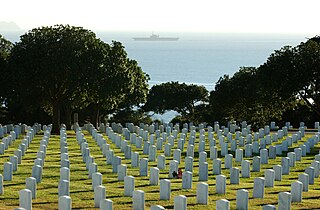
Fort Rosecrans National Cemetery is a federal military cemetery in the city of San Diego, California. It is located on the grounds of the former Army coastal artillery station Fort Rosecrans and is administered by the United States Department of Veterans Affairs. The cemetery is located approximately 10 miles (16 km) west of Downtown San Diego, overlooking San Diego Bay and the city from one side, and the Pacific Ocean on the other. Fort Rosecrans is named after William Starke Rosecrans, a Union general in the American Civil War. The cemetery was registered as California Historical Landmark #55 on December 6, 1932. The cemetery is spread out over 77.5 acres (31.4 ha) located on both sides of Catalina Blvd.

A hospital corpsman (HM) or corpsman is an enlisted medical specialist of the United States Navy, who may also serve in a U.S. Marine Corps unit. The corresponding rating within the United States Coast Guard is health services technician (HS). The U.S. Navy Hospital Corps was created in 1898, with hospital corpsman used as a generic name for the applicable personnel while various other official names were used for the rating; after World War II, hospital corpsman became the official name for the rating.

Terry D. Scott is a former United States Navy sailor who served as the 10th Master Chief Petty Officer of the Navy, from April 22, 2002, to July 10, 2006.

James Lee Herdt is a retired senior sailor in the United States Navy who served as the ninth Master Chief Petty Officer of the Navy from March 27, 1998, to April 22, 2002.
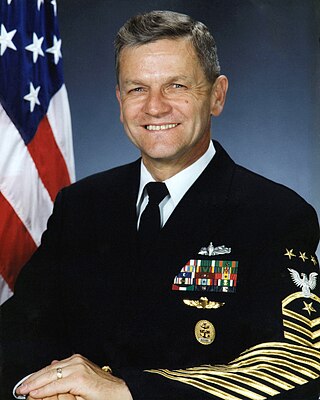
John Hagan is a retired senior sailor of the United States Navy who served as the eighth Master Chief Petty Officer of the Navy.

Duane R. Bushey is a retired senior sailor of the United States Navy who served as the seventh Master Chief Petty Officer of the Navy.

Thomas Sherman Crow, fourth Master Chief Petty Officer of the Navy was born in 1934, in McArthur, Ohio, and graduated from McArthur High School in 1952. After battling cancer, he died at his home in San Diego, California on November 30, 2008. He was interred in Fort Rosecrans National Cemetery in San Diego, California.

Robert James Walker, Sr. was a senior sailor in the United States Navy who served as the third Master Chief Petty Officer of the Navy. He was born in Baldwin, New York, and attended grammar and high school in Oxford, New York.
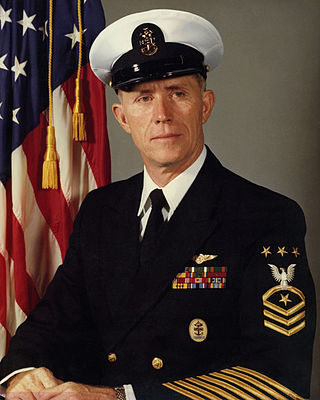
Billy C. Sanders is a retired senior sailor of the United States Navy who served as the fifth Master Chief Petty Officer of the Navy.
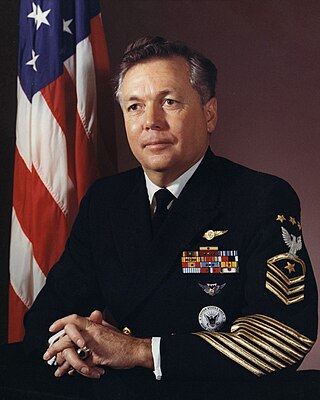
John Donaldson Whittet was a senior sailor in the United States Navy who served as the second Master Chief Petty Officer of the Navy.

Rick D. West is a retired United States Navy sailor who served as the 12th Master Chief Petty Officer of the Navy.
Chief petty officer (CPO) is the seventh enlisted rank in the United States Navy and U.S. Coast Guard, is above petty officer first class and below senior chief petty officer. The term "rating" is used to identify enlisted job specialties. In this way, enlisted personnel are segregated into three segments containing different enlisted ranks. Furthermore, rates are broken down into three levels: non-rated members without a designated occupation. Advancement to E-4 and above is dependent on graduating from a specialty school that define what the enlisted is rated for. Petty officers and chief petty officers are part of the rated force and considered extremely knowledgeable about their particular rating. Examples include Culinary Services Chief and Aviation Maintenance Chief. The Chief Petty Officer is the rank. Gunners Mate is a rating. E7 is a pay grade. The term rating is used to identify the career field of a chief petty officer. For example, the title of a chief petty officer in the Master-at-Arms rating would be spoken or spelled out as Chief Master-at-Arms. The title would be abbreviated MAC. The grade of chief petty officer was established on 1 April 1893 in the United States Navy. The United States Congress first authorized the Coast Guard to use the promotion to Chief Petty Officer on 18 May 1920. Chief petty officer is also the final cadet grade in the United States Naval Sea Cadet Corps.

Michael D. Stevens is a United States Navy sailor who served as Master Chief Petty Officer of the Navy (MCPON). He became the 13th MCPON on September 28, 2012, when he accepted the passing of the ceremonial cutlass from outgoing MCPON Rick D. West. He was succeeded by Steven S. Giordano on September 2, 2016.

The Master-at-Arms (MA) rating is responsible for law enforcement and force protection in the United States Navy—equivalent to the United States Army Military Police, the United States Marine Corps Military Police, the United States Air Force Security Forces, and the United States Coast Guard's Maritime Law Enforcement Specialist. It is one of the oldest ratings in the United States Navy, having been recognized since the inception of the U.S. Navy.
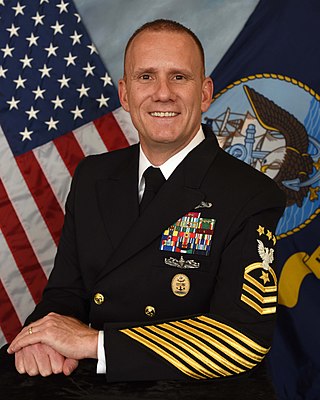
Steven S. Giordano is a retired United States Navy sailor who served as the 14th Master Chief Petty Officer of the Navy.

Russell L. Smith is a United States Navy sailor who served as the 15th Master Chief Petty Officer of the Navy (MCPON). He was acting MCPON from June 22, 2018, when Steven S. Giordano resigned, to August 29, 2018, when he officially assumed the role.

James M. Honea is a United States Navy sailor serving as the 16th Master Chief Petty Officer of the Navy since 8 September 2022. He was previously the Senior Enlisted Leader of United States Indo-Pacific Command from August 2021 to June 2022.



















